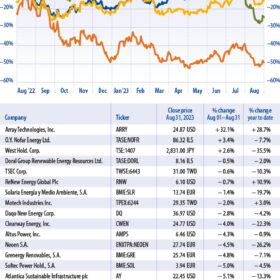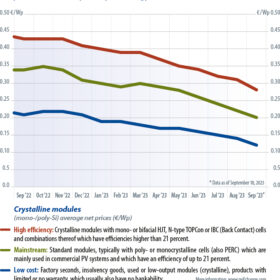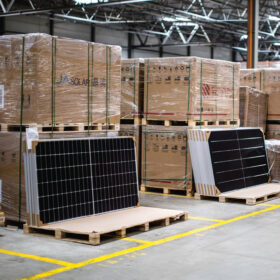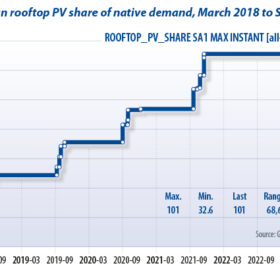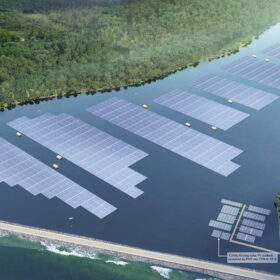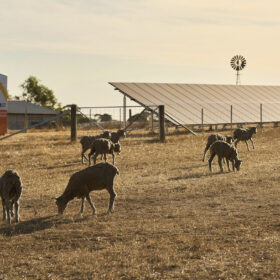Applications for market balance
The pendulum has swung back. PV module prices are falling rapidly once again. After a period of pandemic-disrupted supply chain and supply constraint – and resultant higher prices – intense competition on cost-per-Watt has re-emerged. The development may have caught some by surprise and will likely lead to a painful period for many. But it […]
Capital constraints
The Invesco Solar exchange-traded fund (ETF) TAN under-performed relative to the S&P 500 and the Dow Jones Industrial Average (DJIA) in August. Roth Capital Partners’ Jesse Pichel attributes this to pessimism around United States residential PV and rising interest rates, which are restricting access to capital for some.
Module prices falling with no end in sight
The fall in panel prices shows no signs of stopping. As profit margins vanish, some solar companies are being forced to engage in damage control or face worse consequences. Martin Schachinger, from the solar wholesaler pvXchange, examines the causes and impacts of the trend.
Will New Delhi hear the call from solar developers?
Falling solar equipment prices, bulk module orders, and an expansion in domestic solar manufacturing capacity are driving a solar boom in India. The government can add further impetus if it tweaks domestic content rules, according to Josefin Berg of S&P Global Commodity Insights.
Supply tightens as n-type expands
The market share of high-efficiency, negatively-doped, “n-type” solar products, primarily tunnel oxide passivated contact (TOPCon) and heterojunction (HJT) panels, will reach 25% to 30% this year, compared to just 7% in 2022. By 2024, n-type technology will surpass paasivated emitter rear contact (PERC) to become the next-generation mainstream cell tech. InfoLink has found multiple niches along the supply chain that are affected by this switch in technologies, including the supply of high-density wire mesh used in the screen-printing process.
Evaluating solar vendors
The United States module supply market is rapidly changing. Regulatory, technical, and market dynamics are in flux, creating new challenges for module procurement, writes Brian Hansen, associate director for supply chain management at Clean Energy Associates (CEA).
Pure PV
Australian rooftop PV continues to thrive, with distributed arrays set to reach 6 GW of generation capacity this year, begging the question, when does a lot of rooftop solar become too much? That is a hot debate in the world’s small-scale PV capital, reports Jonathan Gifford.
The ‘next big thing’
The PV industry in Southeast Asia has come a long way since guest author Ragna Schmidt-Haupt, partner at Everoze, reported on solar financing innovation in the region more than a decade ago. In this article, she outlines five factors for success, the newest of which has the potential to become a game changer, and not only in Southeast Asia.
Policy, please
This year, the prestigious Becquerel Prize was awarded to Meyer Burger CEO Gunter Erfurt for his years of hard work and leadership in the European PV industry. pv magazine caught up with Erfurt after he accepted the award at the European Photovoltaic Solar Energy Conference in Lisbon in September.
Feeding the appetite for low-carbon food
Australia’s vast distances make the supply of electricity via traditional grids expensive and even dangerous. With demand growing for agricultural goods produced with low-carbon emissions, solar and energy storage is being embraced even by skeptical farmers.

